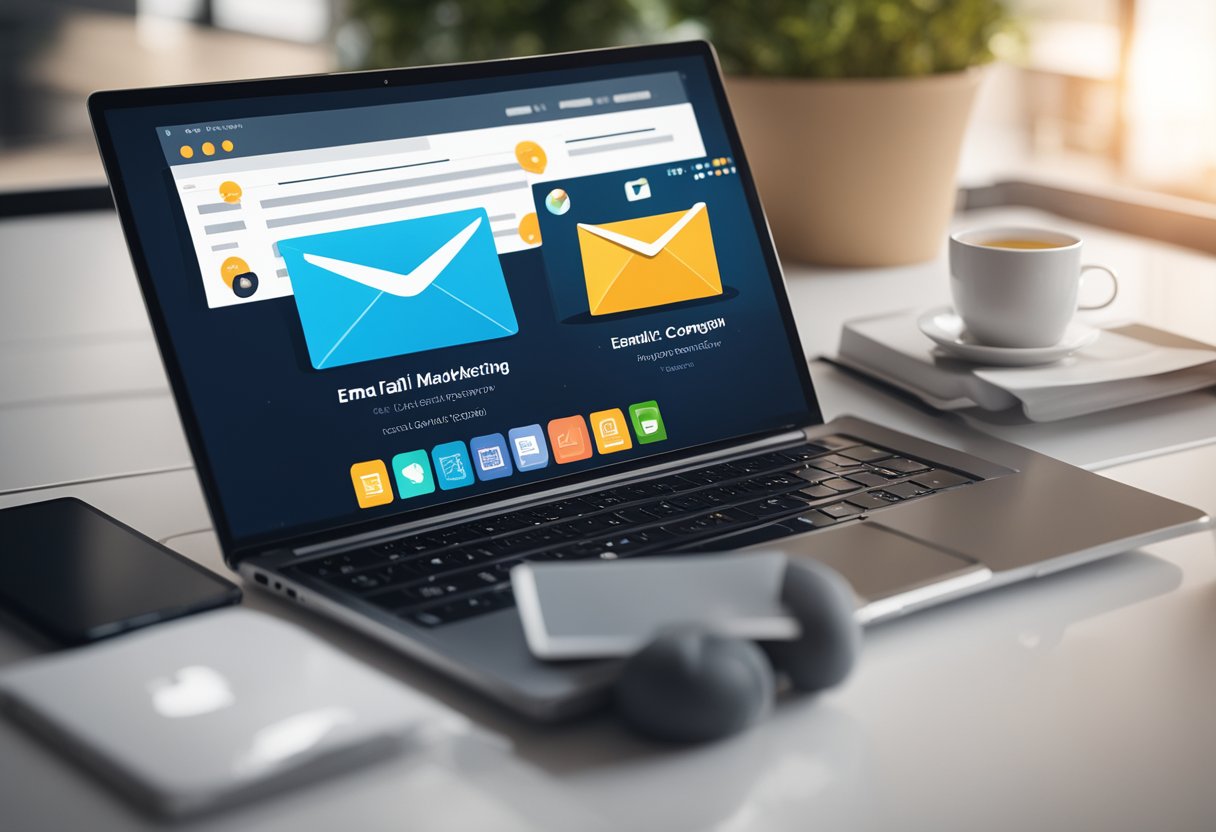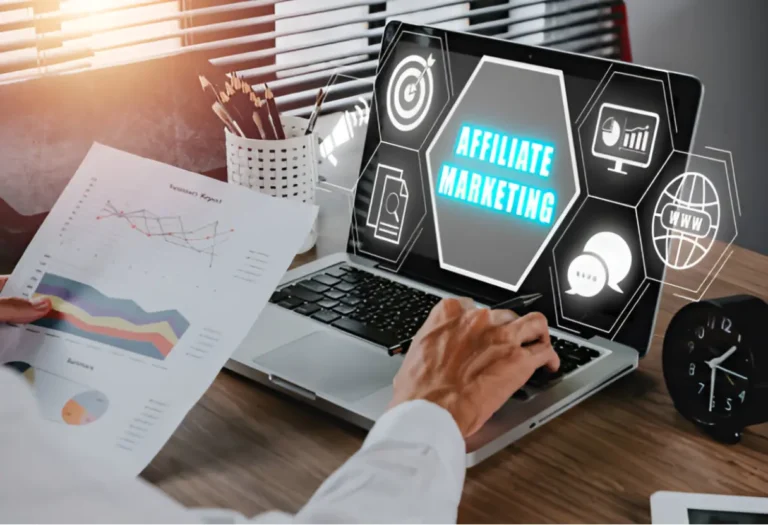5 Ways to Engage Subscribers with Email Marketing
Email is still a key player in Digital marketing, helping businesses reach their audience and achieve goals. But with so many emails in every inbox, how do you make yours shine? The secret is a smart, multi-faceted Email marketing plan. But what are the essential strategies to make your emails exciting and keep your subscribers looking forward to more?
Key Takeaways:
- Craft compelling subject lines to pique your subscribers’ interest
- Personalize email content to make it relevant and valuable for your audience
- Leverage email automation to streamline your campaigns and boost engagement
- Design mobile-friendly emails to ensure optimal user experience
- Analyze and optimize your email performance to continuously improve your strategies
Craft Compelling Subject Lines
Creating a catchy email subject line is key to getting more people to open your emails. It’s the first thing your audience sees, so it’s very important. Here are some tips and best practices for writing great email subject lines.
Tips for Writing Attention-Grabbing Subject Lines
- Make the subject line personal by adding the recipient’s name or other details. This makes it feel more tailored and interesting.
- Use emojis wisely to add a pop of color and grab attention. But, use only one emoji to avoid looking spammy.
- Talk about the problems your audience faces and offer a solution. This makes them curious and more likely to open your email.
- Use words like “limited time” or “last chance” to create a sense of urgency. This encourages people to act fast.
- Ask a question in the subject line to spark curiosity. This makes people want to open the email to find out the answer.
Subject Line Best Practices
Here are some more tips for creating great email subject lines:
- Keep the subject line short, ideally under 50 characters. This ensures it looks good on all devices.
- Use a friendly and conversational tone that fits your brand. It should also resonate with your audience.
- Try out different subject lines to see what works best. Use A/B testing to improve your subject line’s performance.
- Avoid using all caps or too much punctuation. These can make your email look spammy and hurt its delivery.
By following these email subject line best practices and writing attention-grabbing subject lines, you can boost your email subject line tips. This will help you improve subject line personalization and get more people to open your emails.
| Subject Line Tactic | Example | Potential Impact |
|---|---|---|
| Personalization | Hey [First Name], don’t miss this deal! | Increased open rates by 29% |
| Emoji Use | 🔥 Hot deal inside! 🔥 | Improved open rates by 15% |
| Addressing Pain Points | Struggling with email subject lines? | 25% higher click-through rates |
| Urgency/Scarcity | Last chance: 50% off ends tonight | Increased conversions by 21% |
Personalize Your Email Content
In the world of Email marketing, the key to capturing your subscribers’ attention lies in the art of personalization. By using customer data for personalization, you can create personalized Email content that speaks to your audience. This not only boosts subscriber engagement but also strengthens your brand’s connection with customers.
One of the most effective email Content personalization strategies is Email list segmentation. By dividing your email list into targeted segments, you can tailor content to each group’s unique needs and preferences. This approach ensures your messages are always relevant and engaging.
When it comes to Personalized email content, the options are vast. You can offer personalized product recommendations or customize subject lines to grab attention. The goal is to use the customer data you have to create a unique experience for each subscriber.
“Personalization is the key to unlocking Higher engagement and conversion rates in email marketing. By understanding your subscribers’ unique needs and preferences, you can craft content that resonates and inspires action.”
By using email content personalization strategies, you can boost open and click-through rates. This also builds trust and loyalty among your subscribers. As you refine your approach and gather more customer data for personalization, your email marketing will become even more effective.
5 Ways to Engage Subscribers with Email Marketing
Email is still a key tool for businesses to reach their audience. To connect with your email subscribers, try these five strategies:
- Create Valuable and Informative Content: Give your subscribers content that’s useful, educational, or fun. This could be industry insights, special tips, or a peek into your business. Quality content keeps your audience interested and wanting more.
- Offer Exclusive Promotions or Discounts: Give your email subscribers special deals or discounts. This motivates them to stay subscribed and share your emails with others.
- Incorporate Interactive Elements: Make your emails interactive with polls, surveys, or quizzes. These features get your subscribers involved, building a stronger connection and more likely to act.
- Leverage User-Generated Content: Ask your subscribers to share their experiences or photos with your products or services. Using their content in your emails creates a community and proves your products’ value.
- Foster a Sense of Community: Build a community by hosting events, virtual meetups, or discussions. This makes your subscribers feel part of something, fostering loyalty and investment in your brand.
Using these five strategies will help you engage subscribers with email marketing. This leads to meaningful interactions that support your business goals.
Segment Your Email List

Successful email marketing needs a smart approach to segmenting your audience. By dividing your email list, you can make content that speaks to your subscribers. This leads to better open rates, clicks, and sales. Let’s look at why segmenting is good and how to do it well.
Benefits of Email List Segmentation
Segmenting your email list has many perks. It lets you send personalized email campaigns that match your subscribers’ interests. This makes your emails more relevant and valuable, boosting open rates. Plus, segmentation can increase click-through rates and sales by showing subscribers what they want to see.
Segmentation Strategies for Better Engagement
There are many ways to segment your email list, each with its benefits. Here are a few strategies:
- Demographic segmentation: Group subscribers by age, gender, location, or income for targeted email campaigns.
- Behavioral segmentation: Look at user actions like purchases or website visits to make your email list segmentation and email content more personal.
- Psychographic segmentation: Segment based on interests, values, or lifestyle to create personalized email campaigns that connect on a deeper level.
By using smart email list segmentation, you can make your email marketing efforts shine. You’ll give your subscribers a truly personalized experience.
| Segmentation Strategy | Benefits |
|---|---|
| Demographic Segmentation | Enables targeted, personalized email campaigns based on subscriber characteristics |
| Behavioral Segmentation | Allows for personalization based on user actions, leading to higher engagement |
| Psychographic Segmentation | Helps create deeply personalized email content that resonates with subscriber interests and values |
Automate Your Email Campaigns

Email marketing automation is a game-changer. It makes your campaigns more efficient and engaging. With email marketing automation, you can send out personalized messages that really speak to your audience.
Types of Email Automation
There are many types of Email automation to boost your marketing. Here are some key ones:
- Welcome Sequences: These are automated emails that welcome new subscribers and make a great first impression.
- Abandoned Cart Reminders: These emails remind customers about items they left in their carts, encouraging them to buy.
- Triggered Campaigns: These emails are sent when a subscriber takes a specific action, like buying something or visiting your site.
- Nurture Campaigns: These automated emails guide subscribers through the sales process, offering valuable content to help them buy.
Using these Automated email campaigns can save you time and make your emails more personal. Plus, Email automation tools make it easy to set up and improve these strategies.
Automating your emails can change the game. It lets you grow your efforts, care for leads, and get better results. By knowing the types of Email automation and using the right email automation tools, you can elevate your email marketing. This keeps your subscribers happy and loyal.
Design Responsive and Mobile-Friendly Emails
In today’s world, where everyone has a mobile device, making sure your emails work well on phones is key. Creating Responsive email design makes your emails better for users. It also helps get more people to take action and buy from you.
To make your emails work well on phones, follow these tips:
- Make sure images are small and load quickly on phones.
- Use a simple layout with big buttons that are easy to press.
- Make your emails easy for everyone to see by adding text for images and using colors that stand out.
- Use flexible designs that change size and shape to fit any screen.
Also, following email UX best practices makes your emails better for people. This means making it easy to find what you need, organizing your content well, and having a design that’s easy to use.
“Responsive email design is no longer a luxury, but a necessity in today’s mobile-first world.”
By using these tips, you can make emails that are fun to read and work well on phones. This will help you keep your subscribers interested and get the results you want.
Analyze and Optimize Your Email Performance
Effective email marketing relies on data. To get the best results, you need to track key metrics and use what you learn to improve your emails.
Key Email Marketing Metrics
The main metrics to watch include:
- Open rate: How many people opened your email?
- Click-through rate (CTR): How many clicked on a link in your email?
- Conversion rate: How many took action, like buying something.
- Unsubscribe rate: How many stopped getting your emails?
- Bounce rate: How many emails didn’t reach their destination?
Keeping an eye on these metrics helps you see what works and what doesn’t. It shows you how to make your emails better.
Tools for Email Analytics
There are many tools to help you track your email data. Some popular ones are:
- Google Analytics: Works with your email service to give you detailed analytics.
- Email service provider’s reporting: Most platforms have built-in dashboards for tracking.
- Third-party email analytics tools: Tools like Litmus and Mailchimp offer deep insights.
Using these tools helps you make your email strategy smarter. You can keep improving your campaigns to get more engagement and sales.
| Metric | Description | Benchmark |
|---|---|---|
| Open rate | Percentage of recipients who opened your email | 15-25% |
| Click-through rate (CTR) | Percentage of recipients who clicked on a link within your email | 2-5% |
| Conversion rate | Percentage of recipients who took a desired action | 1-3% |
| Unsubscribe rate | Percentage of recipients who opted out of your email list | Less than 0.5% |
| Bounce rate | Percentage of emails that were undelivered | Less than 2% |
By tracking these metrics and using the right tools, you can learn a lot. This helps you make your emails better and get better results for your business.
Leverage Email Interactivity
Email marketing is changing fast, and interactivity is key. It helps grab your audience’s attention and keeps them interested. By adding interactive parts to your emails, you can build stronger connections and get useful feedback.
Interactive emails make your messages feel more personal and fun. You can use polls, surveys, and content that changes based on what users like. This helps you understand your audience better and send messages that speak to them.
Here are some ways to make your emails more interactive:
- Surveys and Polls – Add interactive surveys or polls to your emails. They help you get feedback and see what your subscribers are interested in. This info can guide your content and product plans.
- Interactive Quizzes – Make your emails fun with quizzes. They entertain and let you learn more about what your subscribers like and do.
- Dynamic Content – Use content that changes based on what you know about each user. This could be their location, what they’ve bought, or how they’ve browsed. It makes your emails feel more personal.
- Gamification – Add game-like elements to your emails. This could be points, leaderboards, or games. It makes your subscribers feel like they’re part of something special.
- Clickable Calls-to-Action – Make your calls-to-action interactive. This lets subscribers easily sign up for events, make purchases, or give feedback. It’s a way to get them involved.
By using interactive elements in your emails, you can make your messages more engaging. This leads to more people getting involved, better feedback, and insights to improve your email strategy.
| Interactive Email Elements | Benefits |
|---|---|
| Surveys and Polls | Gather subscriber feedback and insights |
| Interactive Quizzes | Engage subscribers and learn about their preferences |
| Dynamic Content | Deliver personalized and relevant email experiences |
| Gamification | Encourage subscriber participation and build loyalty |
| Clickable Calls-to-Action | Drive direct subscriber engagement and conversions |
Incorporate User-Generated Content

User-generated content (UGC) can change the game in email marketing. By using real, customer-focused content, you can gain trust, boost your brand’s image, and make your emails more interesting.
Benefits of User-Generated Content in Emails
Adding UGC like customer reviews, testimonials, and social media posts to your emails has many advantages:
- Increased Authenticity: UGC offers a real, unbiased view that connects with your audience, building trust in your brand.
- Enhanced Social Proof: Sharing positive feedback shows the value of your products or services, helping subscribers decide to buy.
- Improved Engagement: Curating and sharing UGC makes your emails more relatable and engaging, grabbing your audience’s attention.
- Stronger Brand Loyalty: Featuring customer content in your emails makes them feel valued, boosting loyalty and advocacy.
To make the most of UGC in your emails, focus on curating the best and most relevant feedback, testimonials, and social media posts. This authentic content helps you create customer-centric email campaigns that build trust and enhance your brand’s image.
Stay Compliant with Email Marketing Regulations

Email marketing is a fast-paced field. It’s key to follow rules and regulations to succeed. The CAN-SPAM Act and the General Data Protection Regulation (GDPR) are two big ones.
The CAN-SPAM Act is a US law for commercial emails. It requires clear sender info, opt-out options, and honest subject lines. Not following it can lead to big fines and legal trouble.
The GDPR is a European Union rule about protecting data. It says you need clear consent from people, must tell them how you use their data, and make it easy to unsubscribe. Breaking GDPR can hurt your brand and cost a lot.
It’s also important to build trust with your email list. Keep their data right, respect their privacy, and check your email practices often. This keeps your marketing in line with the best practices.
| Regulation | Key Requirements | Potential Consequences |
|---|---|---|
| CAN-SPAM Act | Clear sender identification Truthful subject lines Opt-out mechanism | Fines up to $43,792 per violation |
| GDPR | Explicit subscriber consent Transparent data usage policies Easy opt-out options | Penalties up to 4% of global annual revenue or €20 million |
Staying true to email marketing rules helps build trust with your audience. It protects your brand and leads to lasting success in email marketing.
Conclusion
Creating an effective email marketing strategy is complex. It needs a mix of best practices for keeping subscribers engaged and making campaigns work. By using techniques like catchy subject lines, personalized content, and automation, businesses can build stronger connections with their audience.
Key to success in email marketing is following the best practices and keeping up with what subscribers want. Using data to improve campaigns is also crucial. This way, businesses can better connect with their audience and achieve their goals.
Email marketing is a continuous journey of improvement. It’s about using data and focusing on the customer. By doing this, businesses can make the most of email marketing and create lasting, profitable relationships with their subscribers.
FAQ
What are the key strategies for engaging email subscribers?
To engage email subscribers, focus on several key strategies. Craft compelling subject lines and personalize your content. Segment your list and automate campaigns for better results.
Make sure your emails work well on all devices. Analyze your performance and optimize your emails. Use interactive content and user-generated content to keep subscribers engaged.
How can I write attention-grabbing email subject lines?
For attention-grabbing subject lines, use personalization and emojis. Address the reader’s pain points and test different tactics. Keep it concise and avoid spam-like language.
How can I personalize my email content to improve engagement?
Personalize your content by using customer data. This includes purchase history and demographics. Segmenting your list helps tailor your emails for better engagement.
What are the benefits of email list segmentation?
Segmentation boosts open rates and click-through rates. It allows for more targeted emails. Use demographics, behavior, or psychographics to segment your list.
How can email automation enhance subscriber engagement?
Email automation delivers timely, personalized experiences. Use it for welcome sequences and abandoned cart reminders. It streamlines your workflow and improves efficiency.
What are the key email marketing metrics to track?
Track open rates, click-through rates, and conversion rates. Also, monitor bounce rates and unsubscribe rates. Analyzing these metrics helps optimize your strategy for better results.
How can I incorporate interactive elements into my email campaigns?
Add surveys, polls, quizzes, and dynamic content to your emails. This fosters connections and encourages participation. Interactive content makes your emails more engaging and personalized.
What are the benefits of using user-generated content in email marketing?
User-generated content boosts credibility and authenticity. It builds trust and engagement. Use customer reviews and social media content in your emails.
What are the key email marketing regulations I need to be aware of?
Familiarize yourself with the CAN-SPAM Act and GDPR. Ensure transparency, obtain consent, and protect subscriber data. These steps help maintain a healthy, trustworthy email list.







